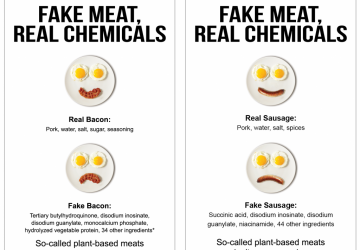New government numbers pose a 64-cent question: Why does obesity warrior Kelly “Big Brother” Brownell fudge the price of produce? “Unhealthy foods,” he says “are the cheapest and easiest to get. Healthier foods are harder to get and cost more.” Leveling this supposedly unequal playing field is Brownell’s justification for an intrusive “fat tax.” But a recently released U.S. Department of Agriculture study tells an entirely different story. It found that Americans can meet food pyramid recommendations for fruit and vegetable consumption “for as little as 64 cents” a day. Those trying to meet the government’s 5-a-day fruits and vegetables challenge “could do so for even less.” USDA concluded that there are “127 different ways to eat a serving of fruits and vegetables for less than the price of a 3-ounce candy bar.” And that’s 127 ways Brownell and other food cops are flat-out wrong.
On average, Americans pay 12 cents for a serving of fresh vegetables and 18 cents for a serving a fresh fruit. “Among the 154 forms of fruits and vegetables” USDA studied, “more than half were estimated to cost 25 cents or less per serving.” Eighty-six percent of all vegetables and 78 percent of all fruit cost less than 50 cents per serving.
While would-be tax collectors like Brownell bemoan the purportedly prohibitive cost of healthful foods, USDA points out that a salad “containing one cup of fresh Romaine lettuce leaves, 1/4 cup of sliced onions, 1/2 cup of cucumbers, and 1/4 cup of sliced carrots costs a total of 43 cents.” That would provide 3 food-pyramid servings of vegetables.
And what about Brownell’s complaint that vegetables are too hard to come by? A separate USDA study noted:
Nationwide, the market for fruits and vegetables has expanded in recent years, with many consumers benefiting from an ever-widening array of fruit and vegetable choices in their local supermarkets. Supermarket produce departments typically carry more than 400 produce items today, up from 250 in the late 1980s and 150 a decade earlier.
Produce is, in fact, cheap and convenient. So it’s no surprise that fruit and vegetable consumption has been on the rise over the last 30 years. According to the USDA, some per capita shifts since 1970 include:
Fresh fruit consumption increased 30 percent;
Fresh vegetable consumption went up 35 percent;
Dark-green leafy vegetable consumption increased 378 percent (with consumption of escarole, romaine and leaf lettuces increasing 1300 percent);
Broccoli consumption went up 365 percent; and
Consumption of beans, peas, and lentils rose 23 percent.
And affordable, healthy options exist for the entire meal. As we’ve noted before, you can go to a typical supermarket and pick up a four pound chicken, a pound of lettuce, a pound of potatoes, and a pound of oranges for a little more than six dollars.




